The Book of Enoch (Chapter 18)
Notes
(18) PROPHECY OF THE ANIMALS (pages 120-135)
Although Enoch says here that it was a dream this is a long and detailed prophecy. The Watchers may have told him to say it was a dream. He has written it in his own words, his style is easily recognizable, particularly where the story is complicated.
Most of the contents of prophecy are now history and are recognizable as bible stories but the end stretches off into the future. There are no names or dates; different animals represent different nations or nationalities. The next chapter, The Ten Weeks, covers the same story but from a different viewpoint.
We start at 85.3 with Adam and Eve, and Cain and Abel. Cain and his descendants are at 85.5. At 85.8 Seth is born to Eve. Next (85.9-10) there is Enoch's family line described in Genesis chapter 5.
The star at 86.1 is the first of the Watchers to appear. They are represented in this story by stars rather than as animals – another indication that they were the real authors or, at least, the editors of this chapter. This first one is the fall of Satan, perhaps a senior member of the Watchers, we don’t seem to have any reliable information on this story, the information here is that Satan caused people to be dissatisfied, they moved around and changed their wives.
The period covered by Enoch's book starts at 86.3 and continues through to 88.3. Here the runaways are described as fallen stars. This is also described at the start of chapter 6 in Genesis - Sons of God (Godlings in Hebrew) desired the daughters of men. These unions gave rise to giants (Nephilim - meaning “to fall”, as in ‘swoop down’).
At 87.2-3 Enoch describes how beings from heaven, and he actually says they looked like white men, raised him to their tower. 88.1-3 seems to describe serious warfare using advanced weapons. It is possible that this war and the events surrounding it are described in the Mahabharata an ancient Hindu text where the gods fight a war with many advanced weapons, nuclear missiles included, judging from the detailed descriptions in the text.
The story of Noah (possibly 17,000 BC) starts at 89.1 and continues through to 89.9. The flood starts at 89.2. Noah's three sons, Shem, Ham and Japheth, give rise to all the animals (nations) at 89.10.
The white bull at the end of 89.10 is Abraham (possibly 2166 - 1991 BC). At 89.11 there is Abraham’s son Ishmael (2080 BC) the wild ass, and Isaac (2066 BC) the white bull.
Isaac has a wild boar, Esau, and a white sheep that is Jacob (2006 BC). At the end of 89.12 Jacob has twelve sons – the patriarchs of the 12 tribes. At 89.13 Joseph is sold to the Ishmaelites or Midianites (asses) and then (1898 BC) to the Egyptians (wolves), see also Genesis 37.25 and 39.1. Genesis 42 onwards is described at 89.14, the time in Egypt. At 89.15, we get to events covered in the book of Exodus.
There is a long section describing the life of Moses (1526 - 1406 BC), at 89.16 – 38; which is probably the reason why Moses believed that Enoch walked with God, (as stated in Genesis 5.22).
89.18 introduces Aaron and the parting of the Red Sea is described by the text at 89.24-25. Crossing the river Jordan (1406 BC), 89.39, is chapter 3 in the book of Joshua. Also in this verse the Judges get a brief mention.
The ram at 89.41 is probably Samuel, followed by Saul, 89.42, (chapter 22 of 1Samuel in the bible), and these are followed by David (1010 - 970 BC) at 89.45. The dogs are the Philistines. The time of Solomon (970 - 930 BC) is at 89.48 and the building of the Temple at 89.50 (the tower). The period after Solomon starts at 89.51 with the deaths of prophets. The one saved, 89.52, is Elijah.
At 89.56, "he left that house of theirs" probably refers to the time of King Manasseh when the Levites took the Ark of the Covenant and left Israel (around 670 BC). They also took Enoch's book, and eventually settled in Ethiopia. The lions in this part are the Assyrians.
There is a change of scene at 89.59, which probably coincides with the religious reforms under Josiah (620 BC) see chapter 34 of 2Chronicles. Then there are the 70 shepherds; these are various religious leaders in Jerusalem since that time.
At 89.66 there is the destruction of the Temple in Jerusalem by the Babylonians (587 BC). The return after the exile (538 BC) is at 89.72. The three who return are Ezra, Haggai, and Zechariah, who all have books in the Bible.
The second temple period, is at 89.73, this is described in Malachi (450 - 400 BC) his book is the last book of the Old Testament.
The eagles first appear in the story at 90.2 they are the Romans.
Fifty-eight of the shepherds have served their time by verse 90.5.
The small lambs with open eyes (90.6) may be the Essenes.
At 90.8 there is the death of John the Baptist - by the ravens.
Jesus is the "sheep with the big horn" at 90.9-16. Interestingly, it does not say specifically that he is killed, only that his ministry is stopped by a conspiracy.
At 90.17, the final twelve shepherds have their own book. This must be the Christian era. The prophecy then goes into the future. At 90.18, God strikes the earth in anger. This is the "second end" in the next section. There are no recognizable events after this, the story goes far off into the future and only time will reveal its meaning.
Audio Video Holy Bible with Text by BibleProject https://rumble.com/BibleProject
The Lost Book of the Bible, https://rumble.com/LTMproject
Need the Rumble Account? Please Click here. https://rumble.com/register/LTMproject/
-
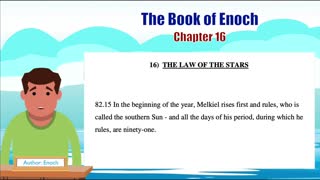 4:05
4:05
LTM project (Wait'n EBS Nesara Gesara QFS GCR Gold Silver 1776 True Republic Redpill)
2 years agoThe Book of Enoch (Chapter 16)
222 -
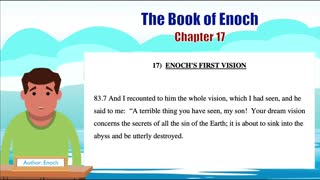 3:53
3:53
LTM project (Wait'n EBS Nesara Gesara QFS GCR Gold Silver 1776 True Republic Redpill)
2 years agoThe Book of Enoch (Chapter 17)
327 -
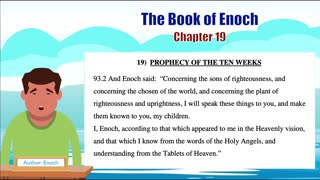 7:04
7:04
LTM project (Wait'n EBS Nesara Gesara QFS GCR Gold Silver 1776 True Republic Redpill)
2 years agoThe Book of Enoch (Chapter 19)
383 -
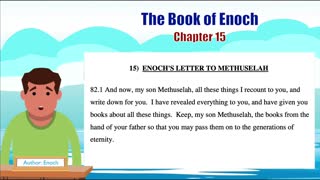 1:42
1:42
LTM project (Wait'n EBS Nesara Gesara QFS GCR Gold Silver 1776 True Republic Redpill)
2 years agoThe Book of Enoch (Chapter 15)
327 -
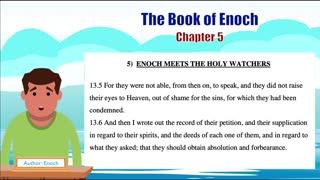 2:37
2:37
LTM project (Wait'n EBS Nesara Gesara QFS GCR Gold Silver 1776 True Republic Redpill)
2 years agoThe Book of Enoch (Chapter 5)
408 -
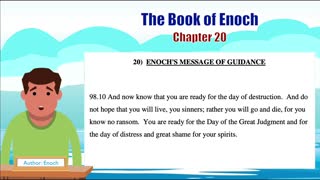 21:32
21:32
LTM project (Wait'n EBS Nesara Gesara QFS GCR Gold Silver 1776 True Republic Redpill)
2 years agoThe Book of Enoch (Chapter 20)
450 -
 8:52
8:52
LTM project (Wait'n EBS Nesara Gesara QFS GCR Gold Silver 1776 True Republic Redpill)
2 years agoThe Book of Enoch (Chapter 12) - 2/4
251 -
 5:16
5:16
LTM project (Wait'n EBS Nesara Gesara QFS GCR Gold Silver 1776 True Republic Redpill)
2 years agoThe Book of Enoch (Chapter 8)
328 -
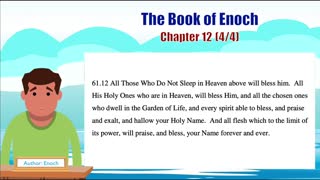 18:16
18:16
LTM project (Wait'n EBS Nesara Gesara QFS GCR Gold Silver 1776 True Republic Redpill)
2 years agoThe Book of Enoch (Chapter 12) - 4/4
270